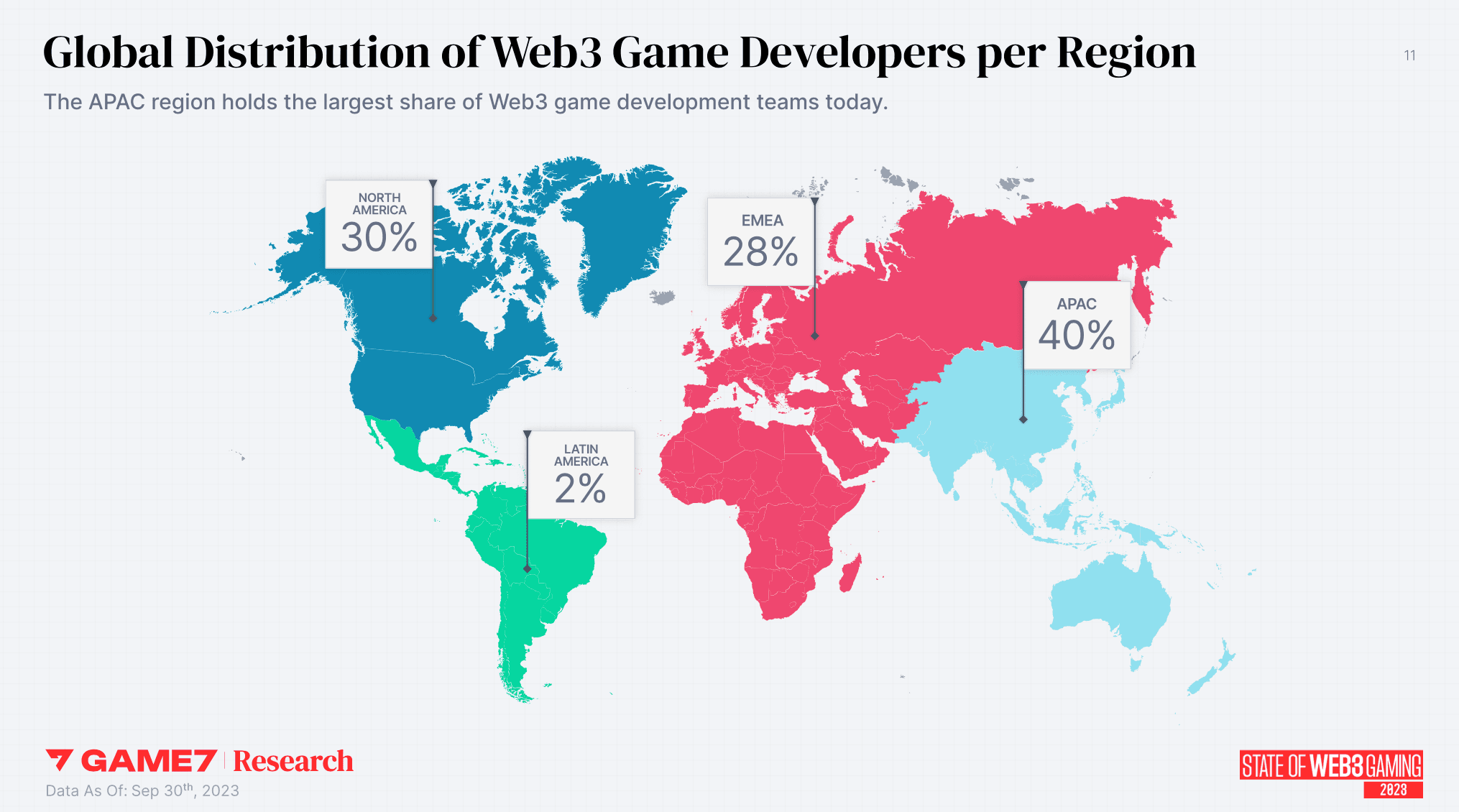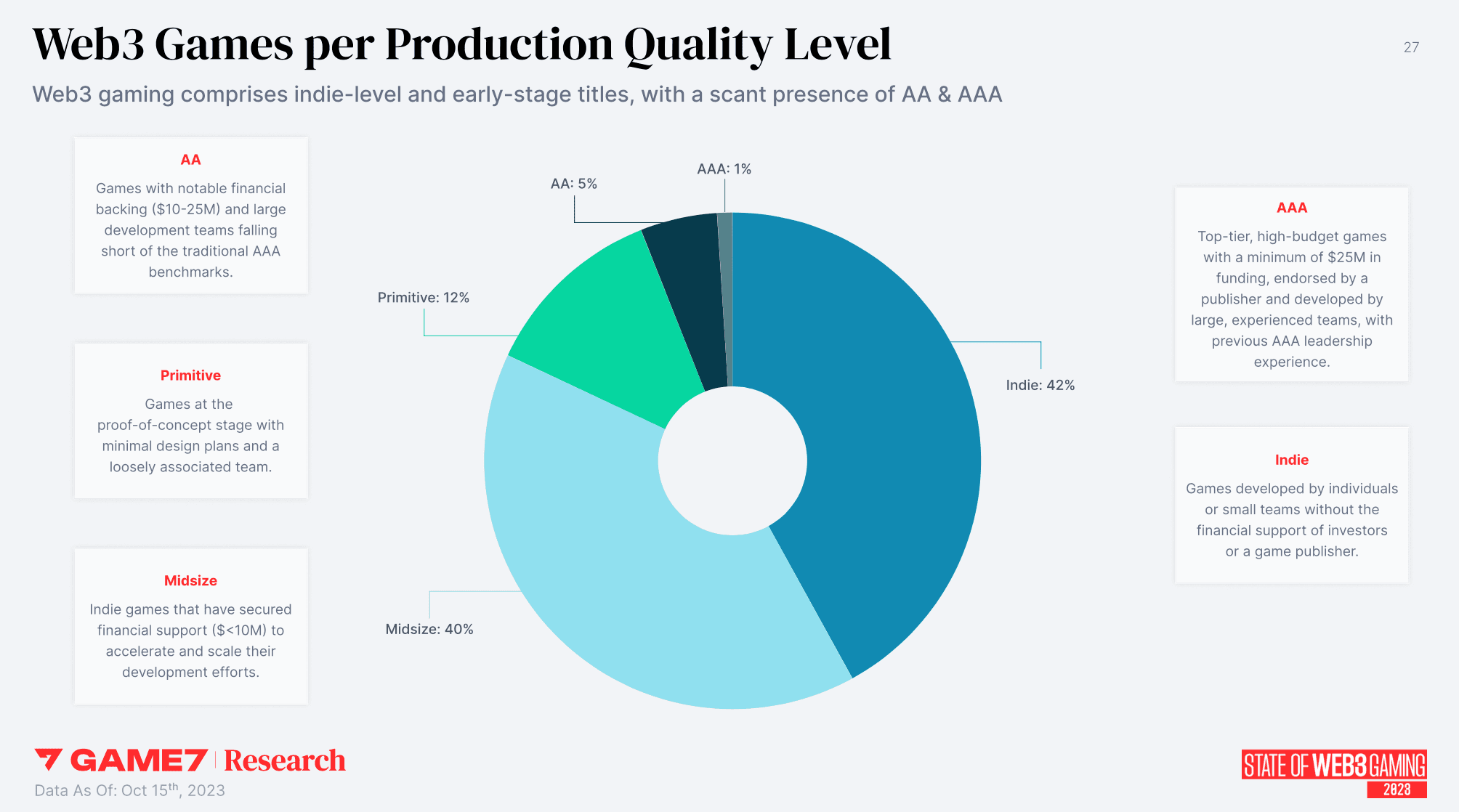
Game7 2023 State of Web3 Gaming Report
In this article, we summarize key findings from the Game7 "State of Web3 Gaming Report" and highlight important insights for the future of web3 gaming.
Game7, a community dedicated to accelerating the adoption of blockchain technology in gaming, just published its State of Web3 Gaming Report. The report was conducted independently to provide an objective, in-depth analysis of the burgeoning web3 gaming sector, revealing essential data, trends, and insights for industry professionals. In this article, we summarize key findings from the report and highlight important insights for the future of web3 gaming.

The report offers a comprehensive view of key ecosystem metrics that have evolved over the past six years. Through rigorous primary research methods, Game7 has captured, examined, and fingerprinted data from almost two thousand web3 games, over one thousand funding rounds, and almost two hundred blockchain ecosystems.
1. Ecosystem
- APAC hosts the majority of web3 game developers (40%), followed by North America (30%). This year, half of the new games entering the space were based in Asia.
- This year, 30% of new web3 gaming teams came from the USA, while South Korea contributed to 27% of web3 gaming teams, almost doubling its contribution from last year.
- The USA remains the largest market for web3 game developers (30%). Other key markets include South Korea (12%), the UK (6%), Singapore (6%), Vietnam (4%), and Australia (4%).

2. Investment
- Investment in the web3 gaming sector saw a massive surge in 2021 and stabilized in 2023, reminiscent of pre-bull market levels. Since 2018, a staggering $19 Billion has been funneled into web3 gaming-related projects.
- The web3 gaming market continues to grow, albeit slower after the 2022 market correction. Until Q3, web3 gaming-related rounds reached $1.5 Billion in 2023, with more than $800 Million being exclusive to web3 gaming, while the rest was shared across multiple verticals.
- US-based web3 gaming projects have attracted more than $4 Billion in funding, with France ($0.9B), Canada ($0.67B), Singapore ($0.67B), and Hong Kong ($0.66B) to follow.
- Sports ($1B), MMOs ($1B), RPG ($0.7B), and Action ($0.3B) game genres have attracted the most funding since 2018.

3. Gameplay
- The web3 gaming ecosystem is chiefly composed of indie-level and midsize projects, making up 94% of the market. Meanwhile, AA & AAA titles are relatively scarce, contributing to only 6% of the market share.
- RPG, Action, Strategy, and Casual games are the most commonly developed genres, with platform-specific preferences revealing RPG and Action as popular on PC, a balanced mix on mobile, and Casual games leading in browser-based games.
- Most web3 games are Free-to-play (F2P) (69%), while 26% of the current titles require players to hold specific NFTs to access the game.

4. Network Stack
- In 2023, more than 81 new blockchain networks that target gaming were announced, growing by 40% YoY.
- The majority of web3 games (81%) are using general-use L1 networks, with EVM sidechains marking a significant portion. L1 networks remained the clear preference for most games launched this year (75%). On the contrary, 51% of new networks were either a L2 (42%) or L3 (9%), mainly driven by the rise of Optimistic L2/L3 solutions.
- Application-specific networks, a new breed of blockchain networks for gaming, accounted for 43% of the newly launched networks this year, growing 84% YoY.

5. Gaming Stack
- Today, 6 out of 10 web3 games are excluded from mainstream distribution platforms and depend on direct channels or web3 native platforms for distribution.
- The Epic Games store has increasingly embraced web3 games, going from only 2 games listed in June 2022 to 69 in October 2023.
- Unity and Unreal Engine command an overwhelming majority (95%) in web3 PC game development.
- Most web3 games (85%) use blockchain technology to tokenize fungible and non-fungible assets while keeping the game state and logic off-chain. Only 5% of the total game population is "Fully-on-chain".

6. Competitive Dynamics
- In 2023, an all-time high number of web3 games migrated to different networks, with Polygon, Immutable, and Arbitrum being favored destinations.
- The Polygon ecosystem hosts most web3 games today, followed by BNB and the Ethereum Mainnet.
- Immutable has emerged as the most popular L2 gaming ecosystem, followed by Arbitrum. Solana remains the largest non-EVM ecosystem of web3 games.
- OP Stack is the leading choice among blockchain frameworks for the creation of new networks aiming at gaming use cases.

Final Thoughts
Overall the report serves as essential reading for game developers, investors, blockchain enthusiasts, and anyone keen on understanding the future trajectory of the web3 gaming space. A full copy of the Game7 2023 State of Web3 Gaming Report is available here.
In the nascent realm of Web3 gaming, better research is how we solve complex problems. This report is our first attempt to index and better understand the broader Web3 gaming ecosystem in a credibly neutral manner, putting core game development pains ahead of tokens and speculation. Challenges can only be met with trustworthy information,” said Steven Chen, Core Contributor at Game7. “Research that is objective, transparent, and clear empowers game developers to make better, more accurate decisions during their development phase. We intend to make this research available to everyone so that anyone in Web3 gaming can benefit from it.
George Isichos, Core Contributor at Game7
About the author
Eliza Crichton-Stuart
Head of Operations
Updated:
February 20th 2024
Posted:
November 14th 2023